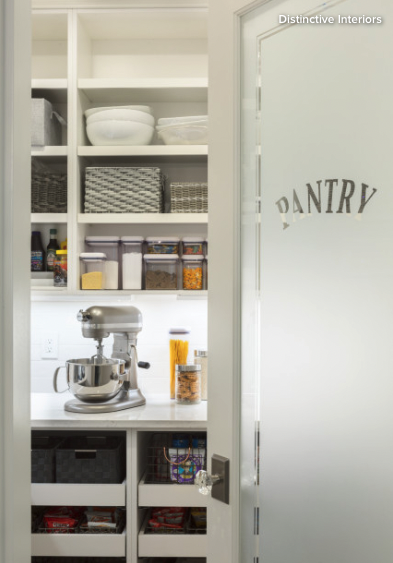It’s only natural to debate whether to go with a walk-in or cabinet pantry when you’re building a new home or redesigning your existing kitchen. Some homeowners want a roomy nook with wall-to-wall shelves and customized inserts, while others are satisfied with just a few shelves and pullouts tucked inside a kitchen cabinet. Here are the pros and cons of both styles.

Walk-In Pantries
Pro: They have more storage capacity. Walk-in pantries are a home chef’s best friend. They take the cake when it comes to sheer volume of storage space. With multiple walls of floor-to-ceiling shelves, they’re big enough to store dozens of ingredients, cookbooks, snacks, pots, pans, medium to large cooking appliances and more.
Con: Storage is more spread out. Bigger isn’t always better, especially when you’re in the mood to whip up a quick dinner. It may take a few extra minutes to gather your ingredients in a large walk-in pantry. Walk-in pantries are also some distance away from appliances and prep space, which can reduce efficiency when you’re cooking. Some homeowners prefer the convenience of having ingredients on hand in their kitchen.
Pro: They can be better organized. Cabinet pantries aren’t inefficient by any means, but walk-in pantries let you get a little more creative with your organization techniques. You can sort your items by row or column, by food group and so on. Consider dedicating a column of shelves to nonrefrigerated fruits and veggies or your most-used oils and spices. You may even have room to house your baking sheets with built-in tray dividers.
Con: They can require more upkeep. A highly organized pantry may come at a price. More space plus more shelves equals more to keep clean and tidy. It takes time and effort to dust off dirty surfaces and declutter shelves. If you’re looking to cut back on your weekly to-do list, you may prefer a cabinet pantry with less storage and less upkeep.
Pro: They can store bigger appliances with ease. Cabinet pantries can house toasters, coffee makers and mixers, but it’s usually at the expense of valuable storage space. Walk-in pantries can comfortably fit larger appliances like microwaves, slow cookers, juicers and deep fryers, freeing up kitchen counter space and ensuring they’re ready to grab when you need them. Some pantries may even have enough space for a second refrigerator.
Con: They take up a lot of space. A downside to walk-in pantries is that they require a lot of space to be functional and efficient. If you’re designing a new kitchen or remodeling an existing one, you’ll have to shrink your kitchen’s footprint to accommodate a walk-in pantry. This can be an issue for homeowners who are short on space to begin with and want to maximize the size of their kitchen.
Pro: They don’t take up a lot of space. Cabinet pantries are on the smaller side compared with walk-in pantries, which require a large footprint. Most measure 24 to 36 inches wide. They’re an efficient storage solution for small or medium-size kitchens, providing a little extra shelf and drawer space without giving up too much in return.
Con: They take up counter space. You’ll definitely lose some counter space, no matter how small your cabinet pantry may be. If you’re designating multiple cabinets as pantry storage, be prepared to give up a significant amount of prep space. Either way, it’s important to navigate the delicate balance of storage and counter space with due diligence. This loss is felt less in larger kitchens but can impact the way a smaller kitchen functions. Consider the size of your kitchen and the way you cook when deciding.
Share: Which storage solution do you prefer — walk-in pantry or cabinet pantry? Tell us in the Comments.








